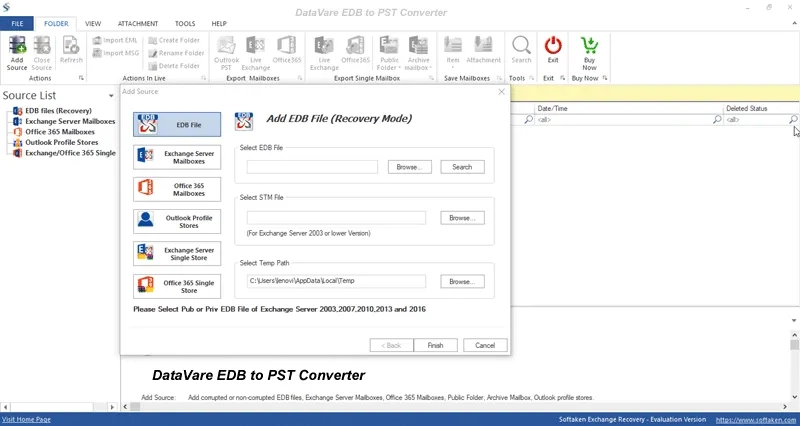Exchange managers regularly export Exchange server mailboxes for backups or another use to PST files. Moreover, converting EDB to PST could fix corruption of your Exchange database files (EDB).
I'll walk over the easiest techniques of Exchange server to PST migration or EDB to PST conversion in this post. Till the very last page, keep reading!
Manual Exchange Server PST Conversion Techniques
Fortunately, exporting mailboxes into a PST file is a feature built-in in Exchange server tools. You may export your Exchange server data using the Classic Outlook program as well. All these techniques, however, are totally time-consuming and laborious. Thus, be absolutely you have sufficient time and technical knowledge before you begin.
Method 1: Linking Exchange server with the Outlook classic application
Outlook's new and vintage versions both let you configure the Exchange server basically. Only the original edition, nevertheless, allows exporting mailbox data. Thus, if you already have the original Outlook added on your smartphone, you can simply join the Exchange server and quickly export folders as required. I have detailed the whole, exact approach here:
- On your Windows computer, click "Mail" after accessing the "Control Panel."
- Click the "E-Letter Accounts" button on the "Mail Setup" wizard. Now on the "Account Settings" window, choose the "E-mail" tab and click the "New" option.
- The "Add New Account," wizard will then show up. Enter all of your Exchange server's required credentials—name, email address, and password—then click on "Next."
Outlook will lastly begin to establish the link with your Exchange server. All the mailboxes should appear on your Outlook program once it's finished. Now, export any folders using the guidelines below:
- View the upper-left portion of your Outlook the dashboard. Here, select the "File" tab. Then choose the "Open & Export" menu and under "Import/Export," click.
- Click Next after selecting "Export to a File".
- There are many output forms to export your folders on the "Export to a File" window. Just click Next after choosing the "Outlook Data File (.pst).
- Choose the folder you wish to export now very deliberately. Make sure to choose the "Include Subfolders" checkbox should any folders under the folder you have chosen be selected. The subfolders won't export otherwise. Just click the "Browse" button and on your local device indicate a location path. After choosing the "Do not export duplicate items," at last click on the "Finish" button.
Exporting your Exchange server mailboxes using the Classic Outlook software follows exactly. Try this approach if your Outlook app is the traditional one. Nevertheless, this approach does not let you export several directories at once.
Method 2: Using the built-in export capability, export an Exchange server to PST.
- Export Exchange user mailboxes as PST format is really simple with the Exchange Admin Center. Users do, however, often run into mistakes and struggle. It's because either the local folder's sharing permission isn't enabled or the Exchange admin center's "mailbox import export" role isn't included. To properly export your user mails, follow the instructions below and closely review screenshots:
- Entering the required credentials will access your Exchange Admin Center.
- Choose the tab "Permissions". Click the "Organization Management" role under "administrative roles," then the "Add" icon.
- After the "Organization Management" pop-up box shows, scroll down and under "roles," click the "+" icon to add another role.
- Choose the "Mailbox Import Export" role now; click "add," then the "Ok" button.
- Once more, ensure the "administrator" is mentioned on the "Organization Management" panel. Add it otherwise by clicking the "+" symbol. Click the "Save" button after that to save every modification you have done.
- You must sign out from the Exchange administrative center and once more sign in to have the modifications taken effect.
- Once logged in, choose the user mailbox you wish to export and click the "three dots" button to access further choices. Then, under "Export to a PST file," click.
- Click on the "Next" button after choosing the "Export only the contents of this mailbox radio button.
- Paste now the exact path of the folder you wish to keep the PST file in. Check if the folder has read and alter sharing rights. You might thus have trouble saving the PST file otherwise.
- As a matter of fact: Under the "PST Export," folder, if you wish to save the PST file on local disk C and your user mailbox name is "xyz," the location path could look like as follows:
C:\PST Export\xyz.pst.
At last, click the "Finish" button to have the PST file stored at the specified location path.
Note: I carried out this approach using the Exchange server 2019. Try to follow Microsoft's advise if you are using any other version.
Quickly migrate emails from Exchange Server to PST
- On their Exchange server, companies and organizations must cope with many user mailboxes. They so find it rather challenging to convert mailboxes one by one. Under such circumstances, EDB to PST converter can facilitate conversion process.
- Run the Datavare EDB to PST converter program on your gadget. Click the "Browse" option to pick an EDB file from your local device. After that, under "Add File," click.
- These days, this program will show every user mailbox that the EDB file has accessible. Click the "Export" button after choosing any mailboxes as fit for your need.
- Clicking the "Browse" button and choosing the output format will specify a location on your local device. Here I am choosing the PST format. Following your choice, click the "Save Data" button.
Your chosen user mailbox will thus be immediately saved on your local device in PST form.
At last
Exchange managers should export their user mailboxes for several reasons, though. Whatever the cause is, you should select the appropriate conversion technique depending on your requirements. You can keep using the hand techniques if you wish to export a few user mails. Otherwise, any professional EDB to PST converter is advised for companies or organizations.





Top comments (0)